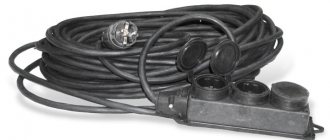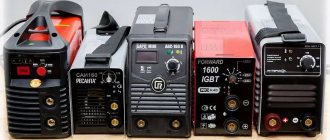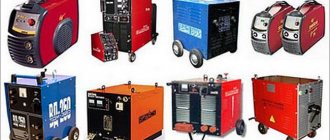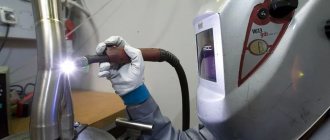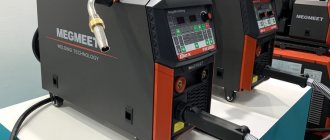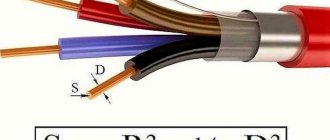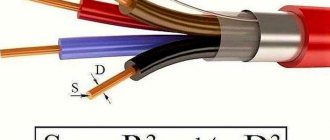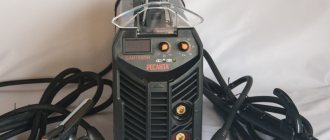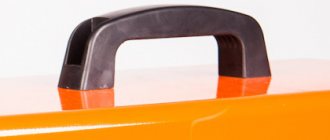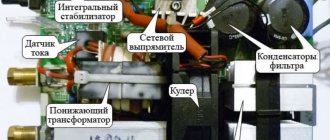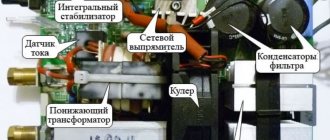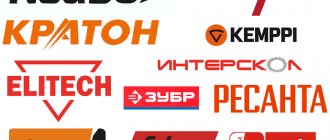Warning
: Parameter 3 to botshadowboxwtw() expected to be a reference, value given in
/var/www/u0099073/public_html/libraries/joomla/event/dispatcher.php
on line
136 Selecting an extension cord for the welding inverter.
Very often, customers ask the question - “Which extension cord should I choose for a welding inverter or a welding transformer?” Let’s try to answer the question of what guides you when choosing an extension cord for welding, more precisely for connecting welding machines, both inverters and transformers.
Read the welding machine instructions carefully. Determine what is the rated power and current of the welding machine. Typically, household inverters and transformers are designed for rated power from 4.0 kW to 5.5 kW at a rated current of 16 Amps (not to be confused with welding current, the value of which can vary from 20-160 Amps) .
Devices over 5.5 kW are already more suitable for the classification of semi-professional and professional welding machines.
Decide on the intensity of use of the welding machine. The intensity of work is determined by the frequency of use, the length of the continuous weld, etc. If you intend to use a welding machine for welding small parts, or for welding in the manufacture of small forms (greenhouse, gazebo, barbecue, fence, porch, etc., even for use in small construction), such use can be conditionally classified as low-intensive use. The use of the device in production, during large-scale construction, for daily constant welding is conditionally classified as high-intensity use.
These conditions are a priority when choosing an extension cord for a welding machine. They determine the choice of wire cross-section. For household welding machines (inverters) with low and medium intensity of use, extension cords with a wire cross-section of 2.5 mm and grounding are suitable. That is, when choosing an extension cord for a welding machine / inverter, pay attention to the wire cross-section.
Example:
Extension cable on reel 40 m “Leader” KG 3 x 2.5 mm
The number “3” indicates that the wire has 3 conductors, “phase”, “neutral” and “ground”, that is, the extension cord is grounded.
The number “2.5” indicates the cross-section of each core.
The letter index KG or PVS indicates the brand of extension cord. You can read more here:
Types of wire for an extension cord on a reel
If the power of the welding machine is over 6.0 kW or the intensity of use of the transformer inverter is high, or the welding machine is designed for 380 Volts, then you can either order an extension cord with a cross-section of over 2.5 mm by calling: 8-495-778-39-90 or by sending an order to our email. You can select a 380 Volt extension cord by clicking on the link in the sections:
Extension cords 380 Volt in coils, “Specialist” series
-The presence of 2 or more sockets on the extension cord is preferable, based on the fact that when welding work, the connection of an additional tool is required - an angle grinder (grinder) or other stripping and cutting tools for cutting metal or cleaning seams. We especially draw your attention to the fact that when ordering a 380 Volt extension cord, it is advisable to have one/two 220 Volt sockets on the extension cord.
-The KG extension cord wire is less susceptible to mechanical and thermal damage than the PVS wire, and can also be used at low temperatures. All about the extension cord wire is here: Types of extension cord wire
— It is more convenient to use and store the extension cord on a reel, since when winding and unwinding from the reel, the extension cord does not bend, break or twist into knots, which is an additional guarantee against breakdown of the wire.
Welding equipment is widely used at home, for which special devices are created that meet the requirements for comfortable home use. The professional field of application also has its own models, and almost always specialists may encounter such a problem as a lack of wire length for work. This situation can be encountered both at home and at work. If with a compact inverter for home you can still go to another place and move it, then with professional equipment this is not always possible. An extension cord for a welding inverter helps solve this problem. Welding machines have quite a lot of power, so switching elements are needed to connect and operate them. These elements will be able to withstand the specified operating parameters. Ordinary household networks and extension cords from them are not always suitable.
Cable requirements for a welder
“What extension cord is needed for a welding inverter?” is the most common question asked by beginners. Taking into account the specific operating conditions, the carrying wire for welding must have the following properties:
- ability to transmit high currents;
- flexibility to move the device around the work site;
- resistance to mechanical damage;
- quality that ensures uninterrupted and safe work.
If the above requirements are met, it is possible to use an extension cord for the welding inverter for welding work.
Characteristics and types of welding cables
The main and only function of the welding cable is to uninterruptedly and without loss deliver electricity to the welding site, where it is converted into heat, which will lead to the melting of the metal and subsequent welding.
The cable consists of two conductors, at one end of which an electrode holder or ground clamp is mounted, at the other ends there are terminals or plugs, as on household welding inverters.
Requirements
The welding cable must pass the operating welding current with minimal losses. Of the available materials, copper has the highest conductivity. So that the wire itself does not heat up, that is, there is no noticeable voltage drop on it, it must be thick enough (large cross-section).
The structures being welded have a complex shape, and welding has to be done in different positions. The electrode must freely reach any place in the structure being welded. Therefore, the welding wire must have maximum flexibility and not interfere with the work.
Classification
The variety of welding units has given rise to a wide selection of conductors, which differ in the number of cores:
- Single core cable . Possessing good elasticity and conductivity, it is used in the operation of welding inverters for household use.
- Twin cable . Each core transmits its own charge - positive and negative. Due to its high conductivity, this cable is used in pulse welding.
- Three-core cable . Used in industrial devices operating at a voltage of 380 V.
The welding cable is made of copper or other metals with high current conductivity.
Conductors are marked with letters and numbers. Explanation of the designations of the most popular extension cords for welding inverters is given below :
- 1-3 – determines the number of cores;
- VChP / VCh P – high-frequency current of direct/alternating nature;
- HL – cold-resistant. Can be used at temperatures down to -60 Cº.
- T – tropical. Can be used at temperatures up to +55 Cº.
The most used types are:
- KG – flexible cable;
- KS – welding cable;
- KOG is a particularly flexible cable. A variation of the previous brand. Designed to operate under alternating voltage conditions of 220 V, or constant voltage of 700 V.
When choosing a cable for a welding machine, it is recommended to find out the cross-sectional diameter of the factory cable, as well as the size of the terminals.
Safety precautions when working
- "A" is the class to which it belongs. As mentioned above, there are several of them - KS, CG and there is also its version KOG (especially flexible)
- “B” - this place indicates the operating temperature range. If they are in the range from -40 to +50 degrees, then nothing is written, if from -60 , then the marking is CL (cold-resistant); if there are special antifungal and moisture-resistant additives, it is considered tropical and is designated as “T”. It can withstand up to +50 heat. When it does not burn at all, it is marked as non-flammable - “NG”.
- “B” - a number equal to the number of working cores from 1 to 3 .
- “G” - this last position indicates the cross-sectional area of the cable for the welding machine in square millimeters.
Useful tips Connection diagrams Principles of operation of devices Main concepts Meters from Energomer Precautions Incandescent lamps Video instructions for the master Testing with a multimeter
Selection of section and length
Errors in choosing the required cable cross-section can result in short circuits , which significantly reduce the service life of welding equipment. Under conditions of small cross-section, the current condenses on the fuses. The emergency protection system will respond to this by periodically de-energizing the device.
The ratio of current and power to the cross-section of the welding cable for conductors made of copper and aluminum is indicated in the table:
Selection of the required cable cross-section based on the current and power of the welding machine.
As production tests show, increasing the length of the remote wire does not affect the operating parameters and quality of the weld. However, the vast majority of operating manuals recommend using a cable with factory parameters, and after it wears out - with similar characteristics.
Application
So, you have selected and purchased extension cables. It would seem that it’s time to connect them and start welding. At this stage, many beginners make a number of mistakes, due to which the cables are not effective enough or do not work at all.
First, always straighten the inverter extension cord before use. Don't let it twist into knots or break. This applies to cables of any length. Decide in advance what maximum length is optimal for you and do not buy too long cables, which will be wound into a reel for most of the welding. This is an irrational use. In addition, when coiled, cables can cause increased induction. This is fraught with melting of the wires and failure of the inverter itself.
Also ensure that extension cables do not overheat during operation. Check the wires periodically and pick them up. If you can hold it calmly for a few seconds, then the temperature is not higher than normal. And if the cable gets so hot that you cannot handle it without gloves, then you need to stop welding and check the integrity of the cable.
Excessive heating of the cable also leads to failure of the welding machine and destruction of the cable itself.
As for storage, you need to be careful here too. Do not wrap the wires tightly, as this will deprive them of natural ventilation. Try to store cords in a dry, clean place and do not leave them outside or expose them to direct sunlight. Make sure that the connecting contacts and the cable plug do not become dirty or rusty.
Calculation example for selecting an extension cord
The maximum permissible length of a copper welding cable is determined by the ratio of the maximum cross-section to the correction factor . It is determined by the base current strength:
- 200-500 A. The correction factor is “2”;
- up to 200 A. The coefficient is equal to the result of dividing the applied current by 100.
For example, let’s calculate the maximum allowable length for the Brigadier MMA-180S inverter. The current strength is 180 A. Since the current strength does not exceed 200 A, the correction factor will be 180/100 = 1.8. The manufacturer recommends using a power cable with a cross-section of at least 16 square meters. mm.
Thus, when working with this inverter, the maximum permissible length of the welding cable is: 16/1.8 = 8.89 (meters)
Is it possible to extend the cable?
There is a lot of debate among experts on this topic. They argue about him “until they are hoarse, until they scream.” Some argue that the wire should never be lengthened, as this will lead to a decrease in productivity, safety and quality of the seam. Others argue that since the manufacturers' recommendations do not say anything about this, it can be extended.
There is a simple way out of this unpleasant situation: a longer cable should have a larger cross-section.
When replacing a wire with a longer one, it is important to correctly connect the plug and terminal connectors to it. This is done with mandatory soldering and subsequent crimping.
So, it is permissible to lengthen the wire, but at the same time it is necessary to increase its cross-section and carefully connect the connectors.
Expert opinion
Viktor Pavlovich Strebizh, lighting and electrical expert
Any questions ask me, I will help!
Three-core cables are used by electricians for professional welding machines that are manufactured to work with pipelines. If there is something you don’t understand, write to me!
Features of choice
The choice of cable for the welding unit is carried out depending on the following parameters:
- Voltage in the working network . The parameter specified in the passport must not be less than the network value.
- Device power . As the power of the device increases, the current increases.
- Operating temperature . The operating temperature range of a standard cable is from -20 to +40. If the operating temperature exceeds these indicators, use a cable of a certain design - cold-resistant or tropical.
- Planned bend radius . The minimum bending radius of KG class cables is the sum of eight outer radii. If this condition is not met, it recommends using cables of the “KOG” class - especially flexible cables.
When choosing a cable, pay special attention to the manufacturer's information. By some signs you can determine the quality of the product:
- Cross-sectional area . The product of a responsible manufacturer indicates the usable area of the core.
- Vein formation . A large number of wires indicates flexibility and good throughput.
- External insulation . PVC shell instead of rubber increases service life.
- Wire material . High-quality products are made from copper.
Extension cord for welding machine
To work effectively, welders have to constantly move around the site, and the socket is located in only one place, so in most cases it is simply impossible to do without an extension cord. The most popular cable length that can make your work comfortable is 20-40 m, generally speaking. And in special cases everything is selected individually.
Theory
No matter how many of us love physics at school, it is the school physics course that we will need to remember in order to theoretically calculate the length of our extension cord. Let's remember that the resistance of a copper conductor is calculated as follows: R= 0.017 *L/S. Also in our case, we can use Ohm’s law for an incomplete chain I=U/R.
Let's decipher the letters in our formulas, which can take on any meaning.
- 0.017 – resistivity of copper cable; Copper is taken a priori, since it has the lowest value.
- L - extension length, mm.
- S is the cross-sectional area of the conductor, mm2.
- U is the nominal voltage in the electrical network, V. However, the actual voltage should be measured, since the condition of most networks leaves much to be desired.
- I—maximum inverter current, A.
From the formula R= 0.017 *L/S a simple and obvious conclusion follows: the resistance increases with increasing cable length (at the same time a voltage drop is observed) and decreases with increasing its cross-section. Accordingly, the length and cross-section of the cable must be selected in such a way as not to provoke a voltage drop on this cable. You should absolutely not use home extension cords to connect household appliances. Manufacturers save on the cross-section of the cores of such carriers; they will certainly flare up when the inverter is connected. You should also not use conductors with a cross section of 0.75 mm2 or less. In general, it should be noted that a 2.5 mm2 cable is enough for reliable operation at a current of 160A, you just need to make a “note in the margin” that the wiring to the outlet must withstand such a load.
Those who like to wind the cable into a reel when welding should be warned. The phenomenon of Faraday electromagnetic induction, which inevitably arises around a conductor with alternating electric current, has not yet been canceled. And even if the induction in the coil is too low to lead to undesirable consequences, during prolonged welding the wire will still heat up (heating up to 70 ° C is considered normal). In a tightly wound coil, the cable does not cool and an increase in temperature will inevitably lead to melting of the insulation with all the ensuing consequences. troubles. The copper itself will most likely remain unharmed, since it has a high melting point of 1080 ° C, but the insulation will stick together. Conclusion: work on an unwound cable or, if this is not possible, on a loosely wound one, so that heat dissipation is ensured due to natural air circulation.
Practice
Let's return to the question: what cross-section should I take the extension cord?
Previously, we would have said that if you have a good network at home and the maximum current of your welding machine does not exceed 160A, then you can take 1.5 mm2 - that’s enough. It is faster for the circuit breaker to trip or for the inverter to go into overheat protection than for such a cable to burn out. It is very simple to check this statement: it is enough to place a 160-amp device on a load ballast and turn it up to the maximum current. A cable with a length of 10 m x 1.5 mm2 can last a long time. In our case, the exposure was made for 12 minutes (arbitrarily, this time could be longer or shorter). During this holding time, the cable warmed up, but it was not so hot that it was impossible to grasp it with an unprotected hand (or it began to smoke). That is, a cable with a cross-section of 1.5 mm2 carries a load of 160A, but this, of course, is the limit and it is better not to allow this. However, if you are not going to “scald” the whole day with the “four”, this option is quite acceptable.
Why do we not recommend taking a cross section of 1.5 mm2 today? Very simple. Because they don't report! You take a 1.5 mm2 cable, and it turns out to be 1.1-1.2 mm2. Conclusion: even if you have a good network, take 2.5 mm2. They may not report it either, but in any case this will be enough for household needs.
What length?
It all depends on your network and device. Example from practice. Carrying length is 120-130 m, welding with a Forsazh 161 machine from a shield and a good network: with a “troika” you can weld, but it’s quite difficult, but with an electrode ø2.5 mm you can weld freely and even cut something!
Helpful advice
Which plug and socket should I use?
An ordinary 16A socket and simple high-quality plugs burn and melt at currents above 160A (but these are like consumables). When you buy, be sure to take a magnet with you to the store and “feel” the plug with it (the socket, however, no one will let you take it apart) - is it magnetic or not? Nowadays there are a lot of low-quality goods painted to look like copper or brass.
